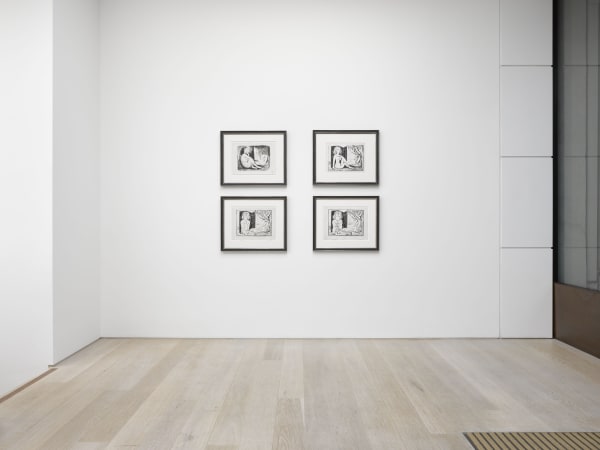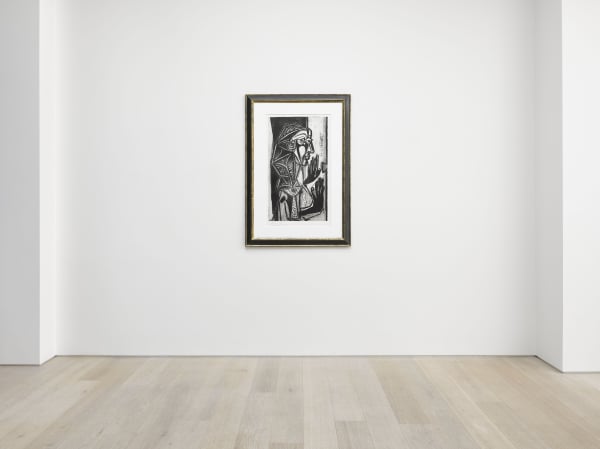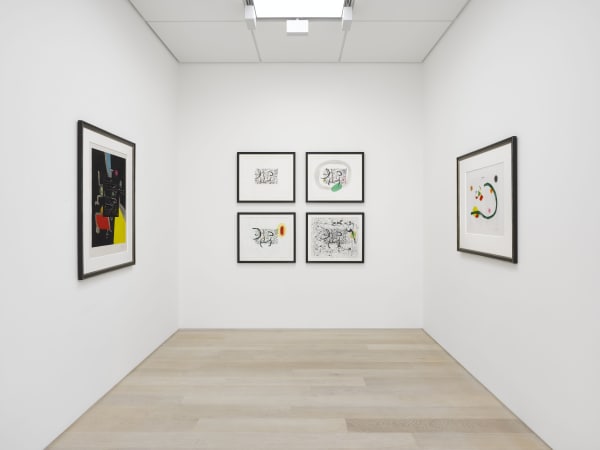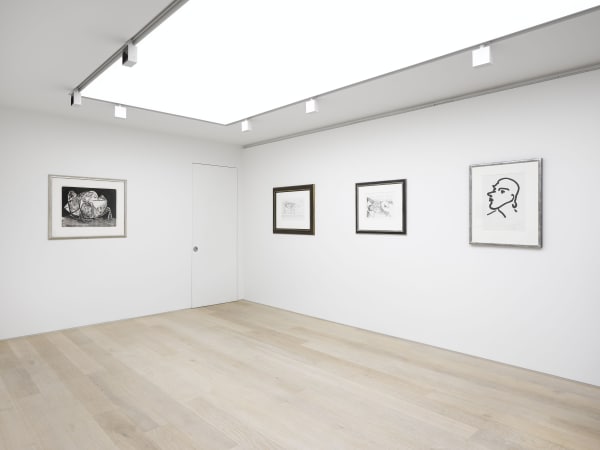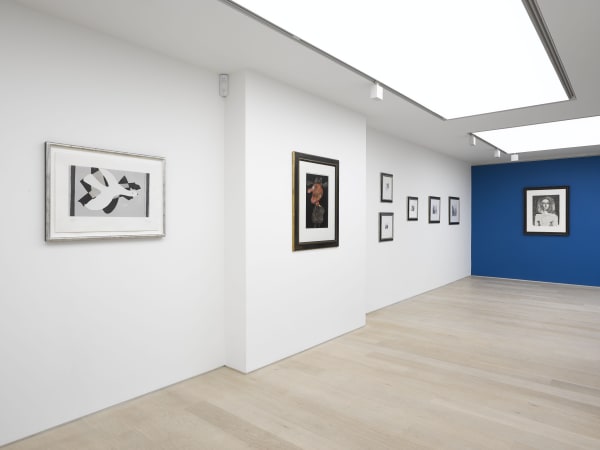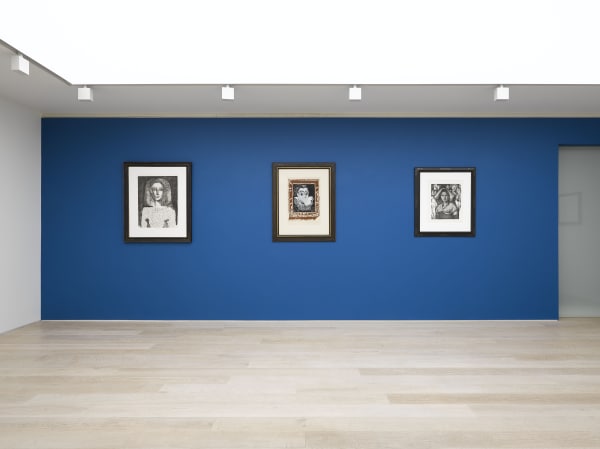Muse & Motif
Muse & Motif at the Alan Cristea Gallery will highlight rare and important prints spanning a 65 year period by six of the twentieth century's greatest artists, George Braque, Jean Dubuffet, Henri Matisse, Joan Miró, Pablo Picasso and Jacques Villon.
A selection of prints covering Picasso's graphic output in every medium, concentrates almost entirely on the figure, with depictions of his muses Françoise Gilot and Jacqueline Roque. These will be shown together with examples of Matisse's most famous etchings illustrating women resting, sleeping and reading. Groundbreaking prints made in the late 1960s by Miró, whose motifs included found images or fragments of words, will be shown alongside one the most striking images of birds made by Braque in the final year of his life.
La Femme a la Fenêtre by Picasso (1881 - 1973) was completed in Paris on 17 May 1952. This portrait of a woman at a window is one of Picasso's most powerful depictions of his lover Françoise Gilot. Gilot, who Picasso began a relationship with in 1944, also appears in Les Deux Femmes Nues, 1945-6, rare progressive proofs for one of Picasso's iconic series made immediately after the Second World War. In this series, as in the famous bull series, Picasso defies expectations by taking classical representation through to abstraction.
Picasso's final muse and his second wife, Jacqueline Roque, whose image dominated so much of his late work, is portrayed in the linocut La Dame à la Collerette (Portrait de Jacqueline à la Fraise), 1962. By the early 1960s Picasso and Jaqueline had left Paris to settle in the south of France. A major drawback to this move was the sheer distance between him and his favoured printing studios in Paris. Picasso looked elsewhere for inspiration, happening upon posters in the local town and he began to make linocut posters for bullfighting events and ceramic exhibitions. Linocut offered him a new freedom in his means of expression and in just a few years he produced around 150 linocut prints. Dispensing with the traditional method of cutting separate blocks for each colour, Picasso cut, printed and cleaned just one piece of lino over and over again to gradually build up an image and create the finished article.
Both Gilot and Jacqueline appear in L'Italienne, 1953. When browsing printmaker Fernand Mourlot's studio Picasso discovered a screened photo-lithograph that had been used to print a poster, depicting an Italian woman, for an exhibition at the Orangerie in Paris in November 1948. Having being informed that the plate was unusable and excited by its possibilities Picasso took it away and returned the next day with a modified plate ready for proofing. He had reworked the image into L'Italienne. By changing the composition of the female face, the woman begins to look like Gilot, his lover at the time, with her open, wide eyes. He then added various other characters, including the first reference to his future wife Jacqueline, depicted bottom left, and himself, depicted top right, playing the castanets. Although the plate was prepared in January 1953, it wasn't printed until 1955 by which time Gilot had left and Picasso had begun living with Jaqueline.
Matisse (1869 - 1954), like Picasso, embraced various printing media wholeheartedly and at times obsessively. For Matisse printmaking came in sporadic bursts throughout his career. In the late 1920s and early 1930s etching and lithography predominated - he created over 100 etchings in 1929 alone - then in a search for greater economy of line, Matisse later turned to linocuts and aquatints.
Early etchings, including Nu au coussin bleu, 1924, feature friends and models posing. These prints will be exhibited together with aquatints Matisse made over twenty years later, and which exemplify the distillation of his work. Working on several plates at the same time, he created each aquatint from just a few gestural brush strokes. These prints in their directness and apparent simplicity, echoed his simultaneous experimentation with cut outs and his decoration of the chapel at St Paul de Vence, France, 1951. The presentation of Matisse's work is completed with the earliest print in the exhibition, Nature Morte aux Poissons Rouges II, 1914-15, a unique monoprint depicting a goldfish bowl, the most recurrent motif in both his paintings and prints of this period.
Miró (1893 - 1983) described his printmaking as engraving the plate with a needle in an automatic way, without any sort of control. Having first made prints in the 1920s, a major breakthrough for his graphic work came when he was introduced to the carborundum printmaking process in the late 1960s. Miró found that by combining prints, this new technique with other etching methods, he could invent 'images to rival any painting'. The importance of his carborundum which includes Tête au Soleil Couchant, 1967 and Le Dandy, 1969 was recognised by the Museum of Modern Art, New York, in 1970 with a dedicated exhibition that toured to several US venues. Following this breakthrough Miró devoted himself primarily to printmaking in the final decade of his life.
The exhibition will include two of Braque's (1882 - 1963) greatest prints, a lithographic flower-piece, Feuilles, couleur lumière, 1953-54, and a depiction of a bird, L'oiseau et son ombre III, 1961. This later print foreshadows a series of images of birds which Braque composed in the last year of his life whilst restricted to his studio in Paris. The birds that passed his window became a symbol of freedom to the artist in his old age. This inspiration, combined with Braque's experimentation in an apparently spontaneous fashion on the etching plate, saw the artist produce his most accomplished image, his final triumph as a printmaker.
Muse & Motif highlights the different ways in which Braque, Dubuffet, Matisse, Miró, Picasso and Villon used the medium of print as a totally original means of expression.
